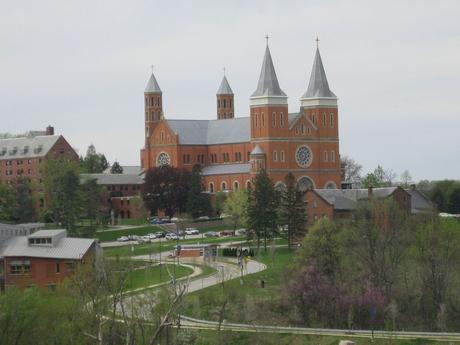There’s a saying that all elections are local. I suspect that’s true. Location is important. There are famous Americans not recognized in other parts of the world. And there are, of course, local celebrities. Having settled once again in Pennsylvania, I’ve taken an interest in local religions. Although not part of the “Burnt-over District” of upstate New York, Pennsylvania, because of its early laws of religious liberty, has produced some noteworthy figures over the centuries. And institutions. When someone mentioned St. Vincent Archabbey, in Latrobe, Pennsylvania, I was curious. I’m not Catholic and even though I’d considered a monastic life, I really knew little about it. St. Vincent is the largest Benedictine monastery in the western hemisphere, as well as the oldest in the United States.
 Image credit: Guerillero, via Wikimedia Commons (Copyleft Free Art License)
Image credit: Guerillero, via Wikimedia Commons (Copyleft Free Art License)
Latrobe isn’t far from Pittsburgh. There is a strong Catholic presence in the area. Like many Catholic institutions, it has a cluster. St. Vincent College, also in Latrobe, must’ve sent me—in those days, print—a prospectus back when I was looking at schools. I’ve known about it for a long time. There’s also a seminary, also called St. Vincent. Probably it’s largest claim to fame is that the Pittsburgh Steelers use the College (I suspect the seminary has no athletic program) for their training camp. Monks and football players—they must have some interesting conversations. I grew up thinking Catholicism was basically some other religion. Fundamentalists, misunderstanding the basics of history, tend to claim that Catholics aren’t Christians. Indeed, until the recent politicization of conservative Christianity, they wouldn’t have had much to say to each other.
Catholicism was frowned upon by the early colonists. While seeking freedom of religion, what they really wanted was freedom of religion for themselves. In good, charitable Christian fashion, many colonies tried to exclude those that believed differently. Especially Papists. Rhode Island and Pennsylvania, however, notably allowed freedom. I’ve lived in Pennsylvania long enough to know that even legal freedom isn’t protection from those locals who’d rather not have Muslims or Hindus for neighbors. And in all likelihood William Penn, a good Quaker, probably couldn’t imagine people of “exotic” religions wanting in. Indeed, the majority of people in this hemisphere weren’t really even aware of “eastern religions” until the 1890s. The religions here were forms mostly of Christianity and Judaism. By 1846 the Benedictines could establish a college, monastery, seminary complex in western Pennsylvania. And it would become the largest and oldest such establishment in a country that still doesn’t grasp true religious freedom.
